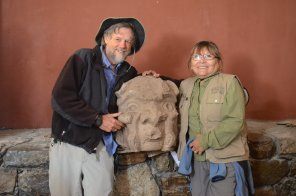Anthropologist John Rick and wife honored by Peruvian government
A career spent exploring sites of early civilizations in Peru is recognized with a special award.
John Rick, professor of anthropology, emeritus, in the School of Humanities and Sciences, and his wife Rosa Mendoza Rick, an archaeologist and co-researcher, have spent decades unearthing a treasure trove of important finds high in the Peruvian Andes. The husband-and-wife team were recently honored by the government of Peru for their work at Chavín de Huántar, a UNESCO World Heritage site.
On May 6, the couple received the Order of Merit for Distinguished Service, an award instituted in 1950 that is given to honor distinguished service to Peru in the fields of the arts, sciences, industry, or business. A small ceremony took place at the Peruvian Consulate in San Francisco. The award was initially bestowed in 2019, but the ceremony was delayed due to the COVID-19 pandemic.
“National-level government recognition by this award is very meaningful and gratifying to us,” said John Rick. “It helps fuel our desire to keep making contributions to knowledge of Peruvian culture.”
The couple has been working in Peru for 50 years, exploring a place that has special significance to them because of her Peruvian heritage.
Chavín de Huántar, which dates to the first and second millennia B.C., has yielded crucial information on how early religious cults strategized the beginnings of political authority in the Andes.
“I believe that people of the past are a natural continuum with ourselves and that societies became increasingly inegalitarian and authority-structured through conscious efforts on the part of some segments of the society,” Rick said.
Artifacts unearthed by archeological field work have shed light on how the interests of some were subordinated to, or regulated, by an emerging ruling structure.
“If we don't understand how we came to be organized, we don't understand ourselves,” Rick said. “Much of that process predates extensive record-keeping, and thus, archaeology is one of our best roads to such understanding.”
Cooperative mapping, excavation, and conservation work at Chavín de Huántar is done under long-term agreements with the Peruvian government.
“We conceived this long-lasting program as a service to the country,” Rick said. “We've gratefully recognized the trust put in us by permitting our work there. Our program team is more than 50 percent Peruvian at all levels, ranging from field workers through leadership roles. In busy years, this means more than 50 Peruvians are involved in field and lab work.”
During his time at Stanford, Rick served as chair of Anthropological Sciences, curator of Anthropological Collections, and director of the Archaeology Center. His teaching concentrated on South American archaeology, the beginnings of social complexity, hunter-gatherers, stone tools, and digital methodologies in archaeology. A previous long-term project focused on early hunter-gatherer cave sites in the 14,000-foot altitude puna grasslands of Peru.
“Inspirational colleagues and incredibly important interactions with the Stanford community have facilitated our decades of fieldwork and analysis,” Rick said. Like many other archaeologists, the couple has relied on graduate and undergraduate field teams. Their work with both social science and engineering student teams has been particularly valuable, in terms of both field work and site conservation.
“It is true that there are no limits to what an interested and motivated Stanford undergrad can achieve—to work with them is a privilege that is intrinsic to any success we have had,” Rick said. But the best part of his adventurous career has been sharing it with Rosa, he said, who helped him become a lifelong devotee of her Peruvian culture.




